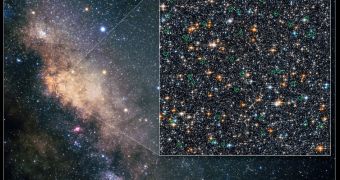A recent study of the central bulge in our galaxy has revealed the presence of a large number of unusual stars called blue stragglers. These rare objects have a tendency of looking much younger than their age should be, astronomers say.
Generally, as stellar objects age, they tend to experience a shift in color. When they are born, they are mostly blue. This color is the hallmark of newly-formed stars. However, as millions of years go by, the objects start turning red.
But blue stragglers retain colors closely related to those they had when they first formed for a lot longer than normal, and experts don't yet have an exhaustive explanation for why that is happening.
Until now, members pertaining to this class of stars have only been observed living inside ancient globular clusters, but never at the core of a galaxy, including the Milky Way. This study is the first to show that this is possible.
During the 7-day Sagittarius Window Eclipsing Extrasolar Planet Search (SWEEPS) survey, which was carried out in 2006 using the NASA Hubble Space Telescope, experts managed to identify a large number of blue stragglers near the center of the Milky Way.
Of the 180,000 stars that Hubble analyzed, 42 are proposed blue stragglers. Of these, between 18 and 37 are surely blue stragglers. Their presence at the galactic core, which is mostly populated by very old stars, is a mystery still.
Astrophysicists agree that the core of the Milky Way stopped producing new stars billions of years ago, so the presence of these oddball stars at that location makes no sense whatsoever. But a possible explanation, experts now say, may lie in the way these stars are formed.
The youthful-looking stars are believed to be born from the smaller member of binary star systems. As the pair whirls around each other, the larger one is feeding its mass to the smaller one, allowing it to grow and to support nuclear fusion for prolonged periods of time.
As more and more mass is accumulated, the smaller star begins to shine brighter, and shifts its spectra from redder to bluer light. This gives it the appearance of a much younger star, Universe Today reports.
“Only the superb image quality and stability of Hubble allowed us to make this measurement in such a crowded field,” explains Will Clarkson, the lead author of the new Hubble investigation.
The expert holds joint appointments at the Indiana University in Bloomington and the University of California in Los Angeles (UCLA).

 14 DAY TRIAL //
14 DAY TRIAL //